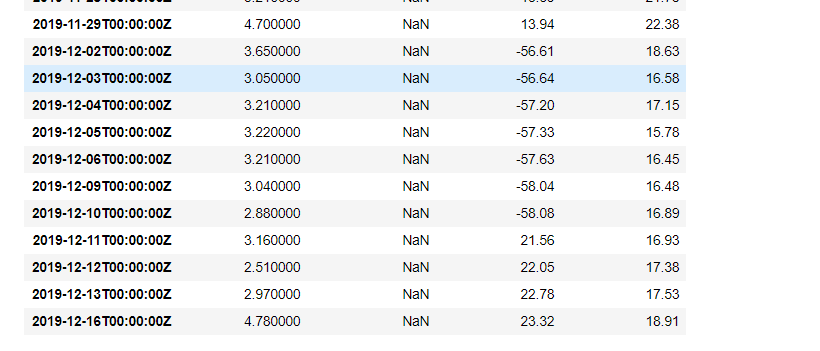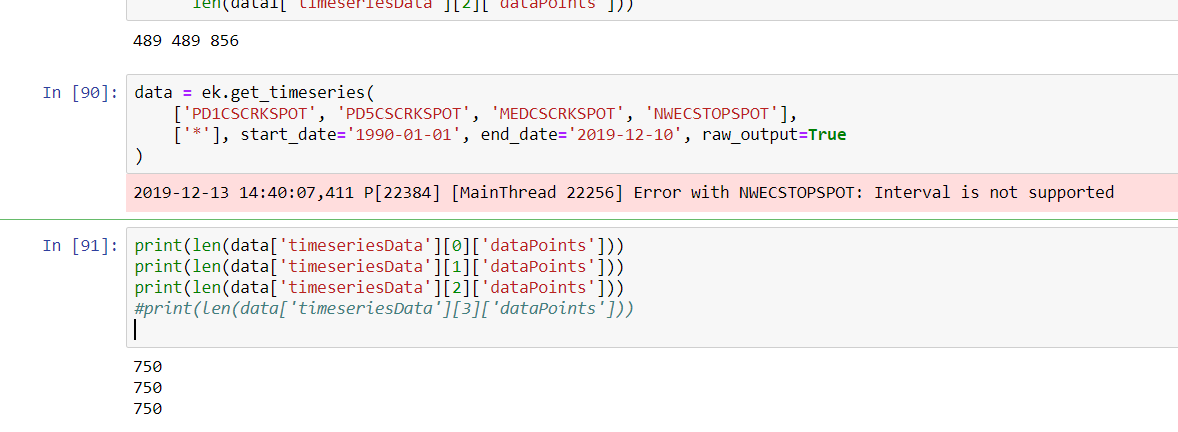Is there a reliable way to get timeseries data via the Eikon Python API? As discussed multiple places on this forum, if the limit of 3000 points is exceeded than extra data points are silently dropped (this limit seems to be approximate as shown below). This leads to very perverse and difficult to detect behaviour, particularly in the case where an extra row is invalid. For example, the following returns data back until 2015-09-04
eikon.get_timeseries( ['PD1CSCRKSPOT', 'PD5CSCRKSPOT', 'MEDCSCRKSPOT'], ['*'], start_date='1990-01-01', end_date='2019-12-10', ) CLOSE PD1CSCRKSPOT PD5CSCRKSPOT MEDCSCRKSPOT Date 2015-09-04 NaN NaN 6.253819 2015-09-07 NaN NaN 5.690739 2015-09-08 NaN NaN 8.134933 2015-09-09 NaN NaN 5.045736 2015-09-10 NaN NaN 5.918317 2015-09-11 NaN NaN 7.658715 2015-09-14 NaN NaN 6.249980 2015-09-15 NaN NaN 6.974118 2015-09-16 NaN NaN 7.591630 2015-09-17 NaN NaN 6.259352 2015-09-18 NaN NaN 5.514481 2015-09-21 NaN NaN 7.870199 ... ... ... ... 2019-11-25 13.61 21.07 5.560000 2019-11-26 14.43 21.14 4.990000 2019-11-27 13.36 21.54 4.900000 2019-11-28 13.39 21.78 5.210000 2019-11-29 13.94 22.38 4.700000 2019-12-02 -56.61 18.63 3.650000 2019-12-03 -56.64 16.58 3.050000 2019-12-04 -57.20 17.15 3.210000 2019-12-05 -57.33 15.78 3.220000 2019-12-06 -57.63 16.45 3.210000 2019-12-09 -58.04 16.48 3.040000 2019-12-10 -58.08 16.89 2.880000 [1077 rows x 3 columns]
Whereas adding a column NWECSTOPSPOT without any data changes the history.
eikon.get_timeseries(
['PD1CSCRKSPOT', 'PD5CSCRKSPOT', 'MEDCSCRKSPOT', 'NWECSTOPSPOT'],
['*'], start_date='1990-01-01', end_date='2019-12-10'
)
Error with NWECSTOPSPOT: Interval is not supported
CLOSE PD1CSCRKSPOT PD5CSCRKSPOT MEDCSCRKSPOT
Date
2016-08-31 NaN NaN 2.762915
2016-09-01 NaN NaN 3.401465
2016-09-02 NaN NaN 5.071215
2016-09-05 NaN NaN 2.855879
2016-09-06 NaN NaN 3.544512
2016-09-07 NaN NaN 4.051888
2016-09-08 NaN NaN 4.668280
2016-09-09 NaN NaN 2.592213
2016-09-12 NaN NaN 3.125617
2016-09-13 NaN NaN 4.002966
2016-09-14 NaN NaN 3.328931
2016-09-15 NaN NaN 5.627774
... ... ... ...
2019-11-25 13.61 21.07 5.560000
2019-11-26 14.43 21.14 4.990000
2019-11-27 13.36 21.54 4.900000
2019-11-28 13.39 21.78 5.210000
2019-11-29 13.94 22.38 4.700000
2019-12-02 -56.61 18.63 3.650000
2019-12-03 -56.64 16.58 3.050000
2019-12-04 -57.20 17.15 3.210000
2019-12-05 -57.33 15.78 3.220000
2019-12-06 -57.63 16.45 3.210000
2019-12-09 -58.04 16.48 3.040000
2019-12-10 -58.08 16.89 2.880000
@alex-putkov mentions in https://community.developers.refinitiv.com/questions/17137/my-get-timeseries-call-is-producing-an-error-which.html that get_data can be used instead, however I do not see a way to use this for my case. In addition, as per https://developers.refinitiv.com/eikon-apis/eikon-data-api/docs?content=49692&type=documentation_item this would still be limited to 10K entries?





